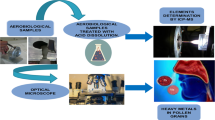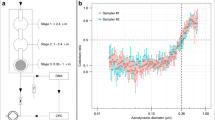Abstract
For a realistic evaluation of the potential hazard emanating from airborne particulate matter (APM), the determination of the total inhaled metal amounts associated with APM is insufficient in risk assessment. Additional information about metal fractions that can be mobilized by the human body is necessary, because only those soluble (also called bioaccessible) fractions can be absorbed by the human body, and thus potentially cause adverse health effects. In the present study, a dynamic flow-through approach as a front end to inductively coupled plasma optical emission spectrometry (ICP-OES) exploiting advanced flow analysis is employed for on-line handling of multiple APM samples and determination of bioaccessible trace metals under worst case extraction scenarios. The method is based on on-line continuous extraction of filter samples with synthetic gastric fluid followed by on-line ICP-OES measurement of the dissolved fraction of trace metals. The assembly permits an automated successive measurement of three sample replicates in less than 19 min. The on-line extraction procedure offers increased sample throughput and reduced risk of sample contamination and overcomes metal re-adsorption processes compared to the traditional batch-wise counterparts. Furthermore, it provides deeper information on the kinetics of the leaching process. The developed procedure was applied to the determination of bioaccessible metal fractions (Al, Ba, Cu, Fe and Mn as model analytes) in PM10 samples from Palma de Mallorca (Spain) and Vienna (Austria).

On-line gastric bioaccessibility of elements in airborne particulate matter






Similar content being viewed by others
References
Dockery DW, Pope CA. Acute respiratory effects of particulate air pollution. Annu Rev Public Health. 1994;15(1):107–32. doi:10.1146/annurev.pu.15.050194.000543.
Pope III CA, Burnett RT, Thun MJ, Calle EE, Krewski D, Ito K, et al. Lung cancer, cardiopulmonary mortality, and long-term exposure to fine particulate air pollution. JAMA J Am Med Assoc. 2002;287(9):1132–41.
Hueglin C, Gehrig R, Baltensperger U, Gysel M, Monn C, Vonmont H. Chemical characterisation of PM2.5, PM10 and coarse particles at urban, near-city and rural sites in Switzerland. Atmos Environ. 2005;39(4):637–51. doi:10.1016/j.atmosenv.2004.10.027.
Puxbaum H, Rendl J, Allabashi R, Otter L, Scholes MC. Mass balance of the atmospheric aerosol in a South African subtropical savanna (Nylsvley, May 1997). J Geophys Res-Atmos. 2000;105(D16):20697–706. doi:10.1029/2000JD900306.
Prieditis H, Adamson IYR. Comparative pulmonary toxicity of various soluble metals found in urban particulate dusts. Exp Lung Res. 2002;28(7):563–76. doi:10.1080/01902140290096782.
Sun G, Crissman K, Norwood J, Richards J, Slade R, Hatch GE. Oxidative interactions of synthetic lung epithelial lining fluid with metal-containing particulate matter. Am J Physiol Lung Cell Mol Physiol. 2001; 281 (4 25–4):L807–L815.
Molinelli AR, Madden MC, McGee JK, Stonehuerner JG, Ghio AJ. Effect of metal removal on the toxicity of airborne particulate matter from the Utah valley. Inhal Toxicol. 2002;14(10):1069–86. doi:10.1080/08958370290084737.
Weichenthal S. Selected physiological effects of ultrafine particles in acute cardiovascular morbidity. Environ Res. 2012;115:26–36. doi:10.1016/j.envres.2012.03.001.
Moreno T, Querol X, Alastuey A, Viana M, Salvador P, Sánchez de la Campa A, et al. Variations in atmospheric PM trace metal content in Spanish towns: illustrating the chemical complexity of the inorganic urban aerosol cocktail. Atmos Environ. 2006;40(35):6791–803. doi:10.1016/j.atmosenv.2006.05.074.
Dongarrà G, Manno E, Varrica D, Vultaggio M. Mass levels, crustal component and trace elements in PM10 in Palermo, Italy. Atmos Environ. 2007;41(36):7977–86. doi:10.1016/j.atmosenv.2007.09.015.
Limbeck A, Handler M, Puls C, Zbiral J, Bauer H, Puxbaum H. Impact of mineral components and selected trace metals on ambient PM10 concentrations. Atmos Environ. 2009;43(3):530–8. doi:10.1016/j.atmosenv.2008.10.012.
Zelikoff JT, Schermerhorn KR, Fang K, Cohen MD, Schlesinger RB. A role for associated transition metals in the immunotoxicity of inhaled ambient particulate matter. Environ Health Perspect. 2002;110(5):871–5.
Birmili W, Allen AG, Bary F, Harrison RM. Trace metal concentrations and water solubility in size-fractionated atmospheric particles and influence of road traffic. Environ Sci Technol. 2006;40(4):1144–53. doi:10.1021/es0486925.
Sato K, Tamura T, Furuta N. Partitioning between soluble and insoluble fractions of major and trace elements in size-classified airborne particulate matter collected in Tokyo. J Environ Monit. 2008;10(2):211–8. doi:10.1039/b709937a.
Heal MR, Hibbs LR, Agius RM, Beverland IJ. Total and water-soluble trace metal content of urban background PM10, PM2.5 and black smoke in Edinburgh, UK. Atmos Environ. 2005;39(8):1417–30. doi:10.1016/j.atmosenv.2004.11.026.
Julien C, Esperanza P, Bruno M, Alleman LY. Development of an in vitro method to estimate lung bioaccessibility of metals from atmospheric particles. J Environ Monit. 2001;13(3):621–30. doi:10.1039/c0em00439a.
Wiseman CLS, Zereini F. Characterizing metal(loid) solubility in airborne PM10, PM2.5 and PM1 in Frankfurt, Germany using simulated lung fluids. Atmos Environ. 2014;89:282–9. doi:10.1016/j.atmosenv.2014.02.055.
Mukhtar A, Mohr V, Limbeck A. The suitability of extraction solutions to assess bioaccessible trace metal fractions in airborne particulate matter: a comparison of common leaching agents. Environ Sci Pollut Res Int. 2015;22(21):16620–30. doi:10.1007/s11356-015-4789-8.
Falta T, Limbeck A, Koellensperger G, Hann S. Bioaccessibility of selected trace metals in urban PM2.5 and PM10 samples: a model study. Anal Bioanal Chem. 2008;390(4):1149–57. doi:10.1007/s00216-007-1762-5.
Mukhtar A, Limbeck A. Development of an ETV-ICP-OES procedure for assessment of bio-accessible trace metal fractions in airborne particulate matter. J Anal At Spectrom. 2011;26(10):2081–8. doi:10.1039/C1JA10125K.
Mukhtar A, Limbeck A. Recent developments in assessment of bio-accessible trace metal fractions in airborne particulate matter: A review. Anal Chim Acta. 2013;774:11–25. doi:10.1016/j.aca.2013.02.008.
Wiseman CL. Analytical methods for assessing metal bioaccessibility in airborne particulate matter: a scoping review. Anal Chim Acta. 2015;877:9–18. doi:10.1016/j.aca.2015.01.024.
Smichowski P, Polla G, Gómez D. Metal fractionation of atmospheric aerosols via sequential chemical extraction: a review. Anal Bioanal Chem. 2005;381(2):302–16. doi:10.1007/s00216-004-2849-x.
Rosende M, Miró M. Recent trends in automatic dynamic leaching tests for assessing bioaccessible forms of trace elements in solid substrates. TrAC, Trends Anal Chem. 2013;45:67–78. doi:10.1016/j.trac.2012.12.016.
Limbeck A, Wagner C, Lendl B, Mukhtar A. Determination of water soluble trace metals in airborne particulate matter using a dynamic extraction procedure with on-line inductively coupled plasma optical emission spectrometric detection. Anal Chim Acta. 2012;750:111–9. doi:10.1016/j.aca.2012.05.005.
Chapter <711>. Dissolution. In: The United States Pharmacopeia and National Formulary USP 37–NF 32; The United States Pharmacopeial Convention, Inc.: Rockville, MD; 2014. p. 344.
Cocovi-Solberg DJ, Miró M. CocoSoft: educational software for automation in the analytical chemistry laboratory. Anal Bioanal Chem. 2015;407(21):6227–33. doi:10.1007/s00216-015-8834-8.
Fedotov PS, Kördel W, Miró M, Peijnenburg WJGM, Wennrich R, Huang P-M. Extraction and fractionation methods for exposure assessment of trace metals, metalloids, and hazardous organic compounds in terrestrial environments. Crit Rev Environ Sci Technol. 2012;42(11):1117–71. doi:10.1080/10643389.2011.556544.
Bacon JR, Davidson CM. Is there a future for sequential chemical extraction? Analyst. 2008;133(1):25–46. doi:10.1039/B711896A.
Ng JC, Juhasz A, Smith E, Naidu R. Assessing the bioavailability and bioaccessibility of metals and metalloids. Environ Sci Pollut Res Int. 2015;22(12):8802–25. doi:10.1007/s11356-013-1820-9.
Rosende M, Savonina EY, Fedotov PS, Miró M, Cerdà V, Wennrich R. Dynamic fractionation of trace metals in soil and sediment samples using rotating coiled column extraction and sequential injection microcolumn extraction: a comparative study. Talanta. 2009;79(4):1081–8. doi:10.1016/j.talanta.2008.10.062.
Rosende M, Magalhães LM, Segundo MA, Miró M. Assessing oral bioaccessibility of trace elements in soils under worst-case scenarios by automated in-line dynamic extraction as a front end to inductively coupled plasma atomic emission spectrometry. Anal Chim Acta. 2014;842:1–10.
Savonina EY, Fedotov PS, Wennrich R. Fractionation of Sb and As in soil and sludge samples using different continuous-flow extraction techniques. Anal Bioanal Chem. 2012;403(5):1441–9. doi:10.1007/s00216-012-5927-5.
Lamsal RP, Beauchemin D. Estimation of the bio-accessible fraction of Cr, As, Cd and Pb in locally available bread using on-line continuous leaching method coupled to inductively coupled plasma mass spectrometry. Anal Chim Acta. 2015;867:9–17. doi:10.1016/j.aca.2015.02.047.
Boonjob W, Zevenhoven M, Ek P, Hupa M, Ivaska A, Miró M. Automatic dynamic chemical fractionation method with detection by plasma spectrometry for advanced characterization of solid biofuels. J Anal At Spectrom. 2012;27(5):841–9. doi:10.1039/C2JA00007E.
Boonjob W, Miró M, Cerdà V. Multiple stirred-flow chamber assembly for simultaneous automatic fractionation of trace elements in fly ash samples using a multisyringe-based flow system. Anal Chem. 2008;80(19):7319–26. doi:10.1021/ac8009609.
Alleman LY, Lamaison L, Perdrix E, Robache A, Galloo J-C. PM10 metal concentrations and source identification using positive matrix factorization and wind sectoring in a French industrial zone. Atmos Res. 2010;96(4):612–25. doi:10.1016/j.atmosres.2010.02.008.
Canepari S, Astolfi ML, Farao C, Maretto M, Frasca D, Marcoccia M, et al. Seasonal variations in the chemical composition of particulate matter: a case study in the Po Valley. Part II: concentration and solubility of micro- and trace-elements. Environ Sci Pollut Res Int. 2014;21(6):4010–22. doi:10.1007/s11356-013-2298-1.
Voutsa D, Samara C. Labile and bioaccessible fractions of heavy metals in the airborne particulate matter from urban and industrial areas. Atmos Environ. 2002;36(22):3583–90. doi:10.1016/S1352-2310(02)00282-0.
Heal MR, Hibbs LR, Agius RM, Beverland IJ. Total and water-soluble trace metal content of urban background PM 10, PM2.5 and black smoke in Edinburgh, UK. Atmos Environ. 2005;39(8):1417–30.
Acknowledgments
V.M. wants to thank the TU Wien for providing a travelling grant for a research stay at the University of the Balearic Islands, Spain in the period May-July 2012. M.M. acknowledges financial support from the Spanish Ministry of Economy and Competitiveness (MINECO) through projects CTM2014-56628-C3-3-R and CTM2014-61553-EXP. The authors are grateful to Dr. David Cocovi-Solberg for the loan of the Cocosoft software.
Author information
Authors and Affiliations
Corresponding authors
Ethics declarations
Conflict of interest
The authors have no conflicts of interest to declare.
Rights and permissions
About this article
Cite this article
Mohr, V., Miró, M. & Limbeck, A. On-line dynamic extraction system hyphenated to inductively coupled plasma optical emission spectrometry for automatic determination of oral bioaccessible trace metal fractions in airborne particulate matter. Anal Bioanal Chem 409, 2747–2756 (2017). https://doi.org/10.1007/s00216-017-0219-8
Received:
Revised:
Accepted:
Published:
Issue Date:
DOI: https://doi.org/10.1007/s00216-017-0219-8




